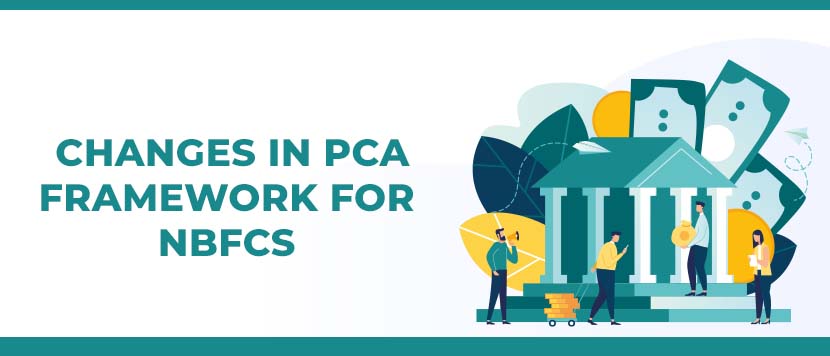Changes in the PCA Framework for NBFCs

Last Updated: 15th December 2022 - 10:26 am
On the lines of the Prompt Corrective Framework (PCA) introduced for banks, the RBI has announced a similar PCA framework for select NBFCs too. These PCA norms will kick in from October 2022 and will be applicable if core parameters of the NBFC dip below a certain threshold. Such companies that are transferred to PCA will be subject to more stringent monitoring as well as a slew of restrictions. This will be applied to large NBFCs in India.
In the last few years, several large NBFCs went bust causing risks to the financial systems. The first such case was IL&FS which the government appointed board took over to manage the liquidation. RBI made a special reference to liquidation in the case of Dewan Housing, SREI Group and Reliance Capital to prevent systemic risks. The PCA framework will be a more formal mechanism to identify, pre-empt and manage such risks better.
In terms of applicability, the reference date will be 31-March 2022. The PCA framework will be applicable to all deposit taking NBFCs and other large ones in the middle and top layer. The PCA regulations will be exempted for non-deposit taking NBFCs with an asset base of less than Rs.1,000 crore. Government owned NBFCs and housing finance companies will be exempt from these PCA regulations.
RBI has pointed to the need to regulate large NBFCs in the light of the huge AUM that they currently deploy and the systemic risks they could pose in the event of default due to their deep linkages in the system. For the applicability of PCA framework, the RBI has prescribed a 3-factor model consisting of Capital Risk Adequacy Ratio (CRAR), Tier-1 capital ratio and net NPA ratio. These criteria will be further dividend into 3 thresholds based on severity.
How will the PCA thresholds be set?
The PCA threshold will be set at 3 levels for each of the 3 parameters with restrictions most severe as the level goes higher. PCA will be triggered if any 1 of the 3 items breach the levels as under.
a) RBI prescribes 15% CRAR for NBFCs. If the CRAR goes to 12-15%, it will be Level 1; if CRAR falls to the range of 9-12%, it will be Level 2 and if CRAR falls to below 9% it would be classified as Level 3.
b) RBI prescribes 10% Tier-1 Capital for NBFCs. If the Tier-1 Capital goes to 8-10%, it will be Level 1; if Tier-1 Capital falls to the range of 6-8%, it will be Level 2 and if Tier-1 Capital falls to below 6% it would be classified as Level 3.
c) RBI does not have a net NPA statutory limit for NBFCs. However, if the Net NPAs goes to 6-9%, it will be Level 1; if Net NPAs goes to the range of 9-12%, it will be Level 2 and if Net NPAs goes above 12% it would be classified as Level 3.
What is the action prescribed by RBI for NBFCs in each threshold?
As mentioned earlier, the PCA framework can be triggered if any of the 3 criteria mentioned above is activated. Based on the severity, the level of PCA framework will be decided. Here is a gist of the regulatory action prescribed.
A) For Risk Threshold 1 as explained above, the RBI stipulations entail, restrictions on dividend distribution, remittance of profits and promoters being asked to bring in additional equity or reducing the leverage in the balance sheet.
B) For Risk Threshold 2 as explained above, the RBI stipulations entail strict restrictions on branch expansion and franchisee expansion. This will be over and above the other restrictions already in place for Threshold 1.
C) For Risk Threshold 3 as explained above, the RBI stipulations entail strict restrictions on capital expenditure, restrictions on operating rights, employee costs, bonus etc. This will be over and above the other restrictions already in place for Threshold 1 and 2.
The proposed PCA framework for NBFCs is likely to put some restrictions on NBFC expansion but will have the larger advantage of regulated growth and avoiding systemic risks.
- Flat ₹20 Brokerage
- Next-gen Trading
- Advance Charting
- Actionable Ideas
Trending on 5paisa
Indian Stock Market Related Articles
Disclaimer: Investment in securities market are subject to market risks, read all the related documents carefully before investing. For detailed disclaimer please Click here.
 5paisa Research Team
5paisa Research Team
 Sachin Gupta
Sachin Gupta




